Analyzing Revenue and Expenses: Aviation Pricing at Two UK Airports
VerifiedAdded on 2023/06/18
|10
|2146
|443
Report
AI Summary
This report provides an analysis of aviation pricing and revenue management, focusing on a comparative study of Land End's Airport and Alderney Airport, two airports of similar size in the United Kingdom. The report identifies and explains three key revenue streams for each airport, including commercial development and advertising, car parking services, and airport services like airline rent counters and landing charges. Additionally, it outlines three key expenses for each airport, primarily labor costs, fuel expenditures, and the impact of these factors on airport activities. It further examines the changes in revenues and expenditures over the past few years, particularly in light of the pandemic's impact. The report concludes by discussing key success factors for managing finances and operating management within the aviation industry. Desklib provides this document as a resource for students studying aviation management and related fields, offering access to past papers and solved assignments.
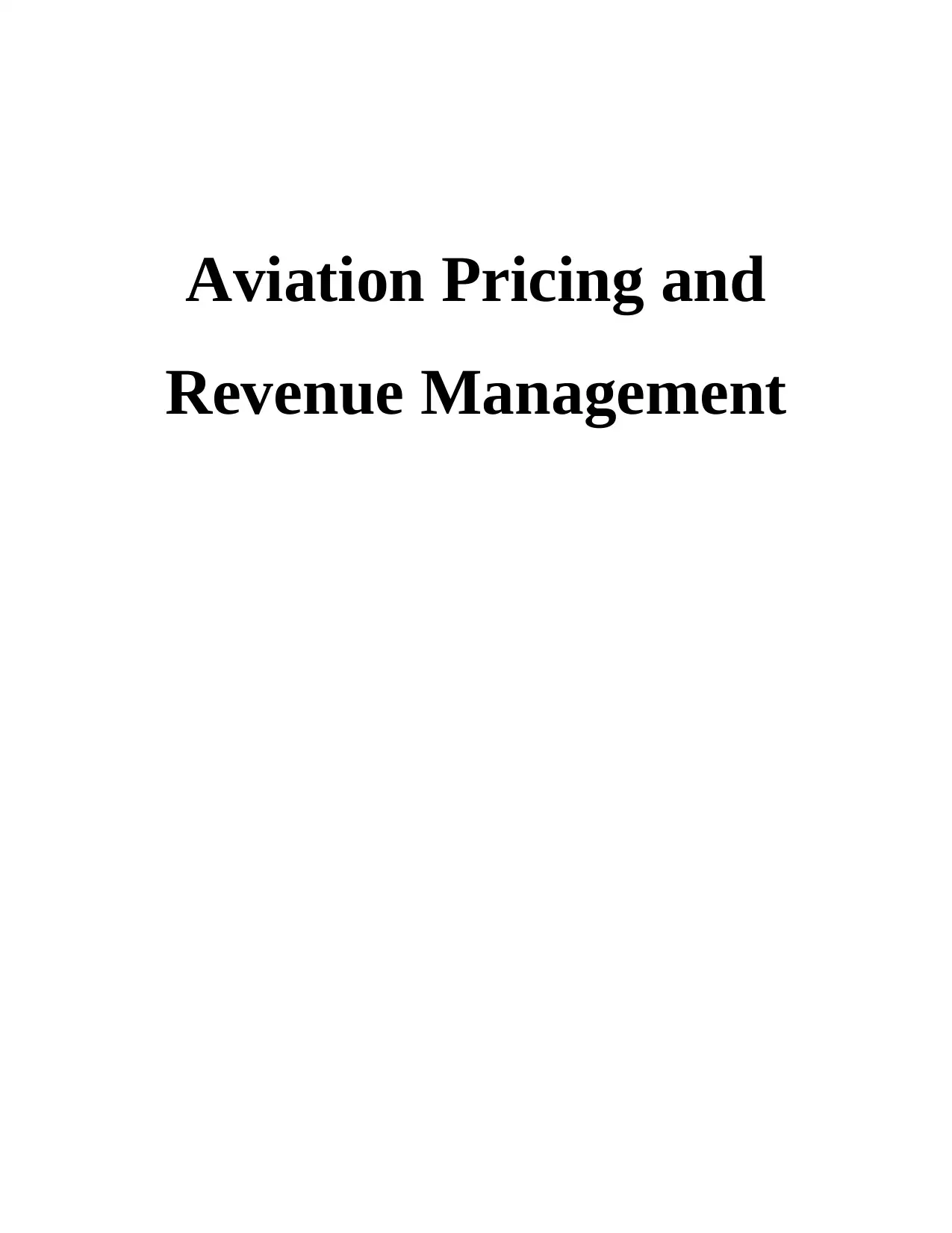
Aviation Pricing and
Revenue Management
Revenue Management
Paraphrase This Document
Need a fresh take? Get an instant paraphrase of this document with our AI Paraphraser

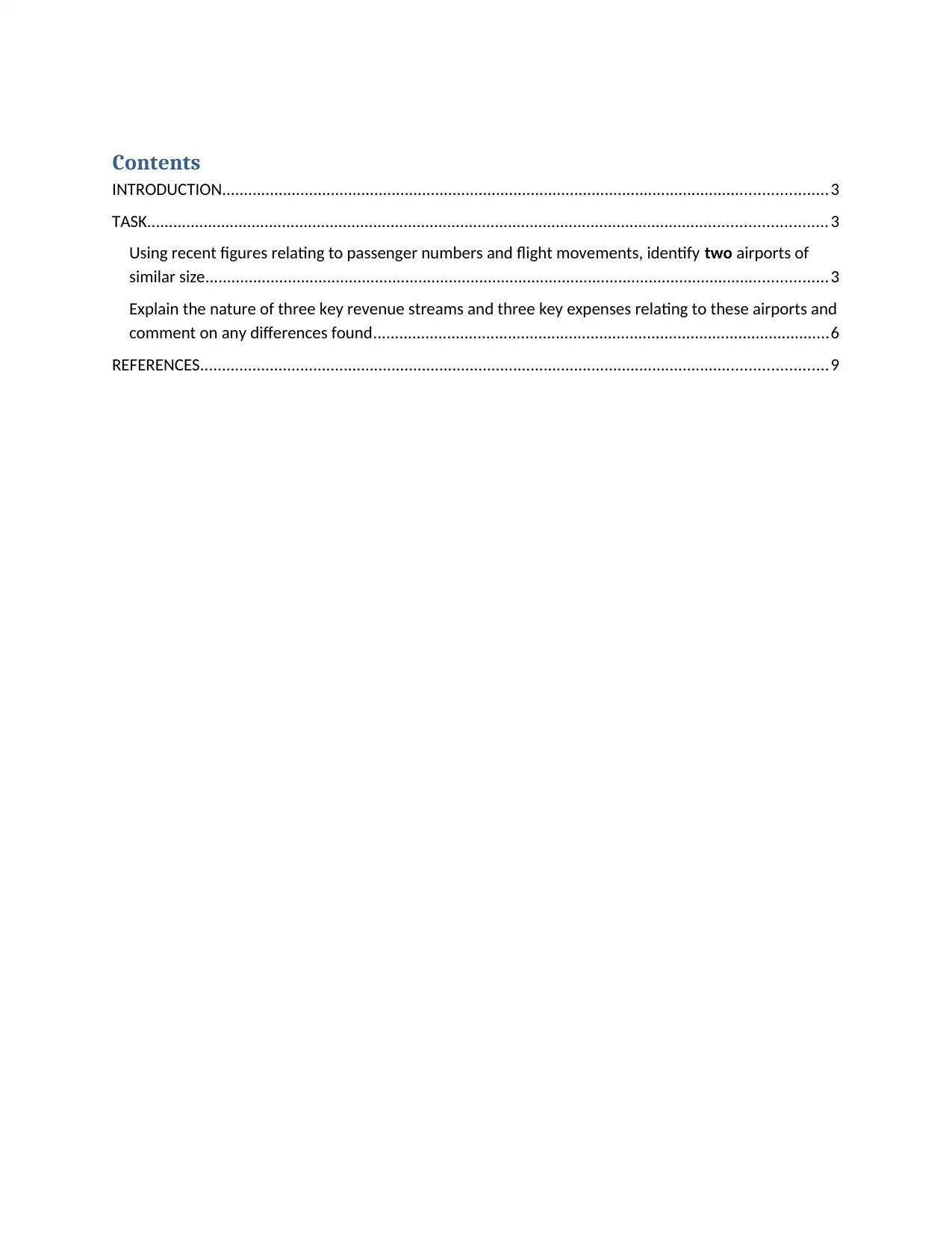
Contents
INTRODUCTION...........................................................................................................................................3
TASK............................................................................................................................................................3
Using recent figures relating to passenger numbers and flight movements, identify two airports of
similar size...............................................................................................................................................3
Explain the nature of three key revenue streams and three key expenses relating to these airports and
comment on any differences found.........................................................................................................6
REFERENCES................................................................................................................................................9
INTRODUCTION...........................................................................................................................................3
TASK............................................................................................................................................................3
Using recent figures relating to passenger numbers and flight movements, identify two airports of
similar size...............................................................................................................................................3
Explain the nature of three key revenue streams and three key expenses relating to these airports and
comment on any differences found.........................................................................................................6
REFERENCES................................................................................................................................................9
⊘ This is a preview!⊘
Do you want full access?
Subscribe today to unlock all pages.

Trusted by 1+ million students worldwide
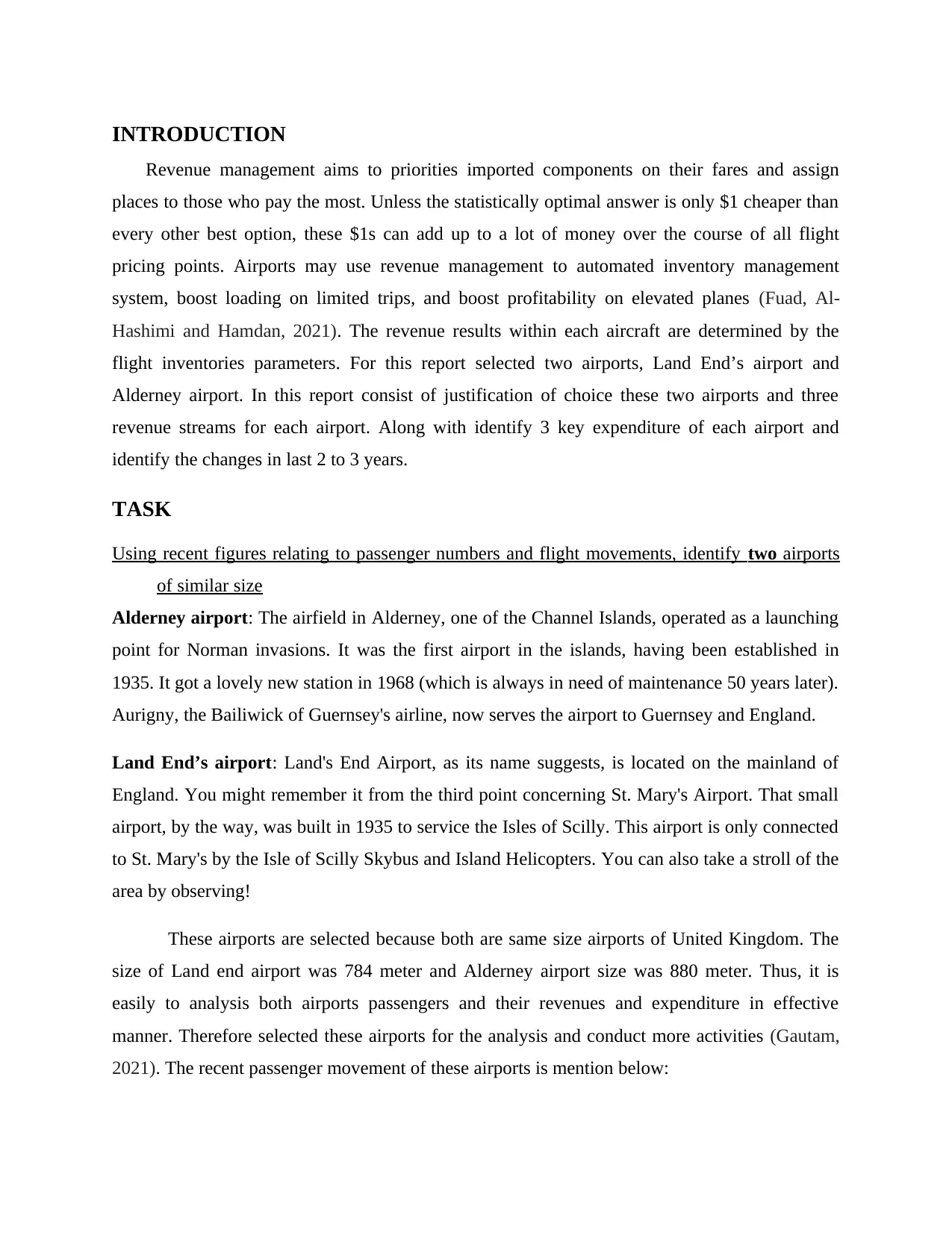
INTRODUCTION
Revenue management aims to priorities imported components on their fares and assign
places to those who pay the most. Unless the statistically optimal answer is only $1 cheaper than
every other best option, these $1s can add up to a lot of money over the course of all flight
pricing points. Airports may use revenue management to automated inventory management
system, boost loading on limited trips, and boost profitability on elevated planes (Fuad, Al-
Hashimi and Hamdan, 2021). The revenue results within each aircraft are determined by the
flight inventories parameters. For this report selected two airports, Land End’s airport and
Alderney airport. In this report consist of justification of choice these two airports and three
revenue streams for each airport. Along with identify 3 key expenditure of each airport and
identify the changes in last 2 to 3 years.
TASK
Using recent figures relating to passenger numbers and flight movements, identify two airports
of similar size
Alderney airport: The airfield in Alderney, one of the Channel Islands, operated as a launching
point for Norman invasions. It was the first airport in the islands, having been established in
1935. It got a lovely new station in 1968 (which is always in need of maintenance 50 years later).
Aurigny, the Bailiwick of Guernsey's airline, now serves the airport to Guernsey and England.
Land End’s airport: Land's End Airport, as its name suggests, is located on the mainland of
England. You might remember it from the third point concerning St. Mary's Airport. That small
airport, by the way, was built in 1935 to service the Isles of Scilly. This airport is only connected
to St. Mary's by the Isle of Scilly Skybus and Island Helicopters. You can also take a stroll of the
area by observing!
These airports are selected because both are same size airports of United Kingdom. The
size of Land end airport was 784 meter and Alderney airport size was 880 meter. Thus, it is
easily to analysis both airports passengers and their revenues and expenditure in effective
manner. Therefore selected these airports for the analysis and conduct more activities (Gautam,
2021). The recent passenger movement of these airports is mention below:
Revenue management aims to priorities imported components on their fares and assign
places to those who pay the most. Unless the statistically optimal answer is only $1 cheaper than
every other best option, these $1s can add up to a lot of money over the course of all flight
pricing points. Airports may use revenue management to automated inventory management
system, boost loading on limited trips, and boost profitability on elevated planes (Fuad, Al-
Hashimi and Hamdan, 2021). The revenue results within each aircraft are determined by the
flight inventories parameters. For this report selected two airports, Land End’s airport and
Alderney airport. In this report consist of justification of choice these two airports and three
revenue streams for each airport. Along with identify 3 key expenditure of each airport and
identify the changes in last 2 to 3 years.
TASK
Using recent figures relating to passenger numbers and flight movements, identify two airports
of similar size
Alderney airport: The airfield in Alderney, one of the Channel Islands, operated as a launching
point for Norman invasions. It was the first airport in the islands, having been established in
1935. It got a lovely new station in 1968 (which is always in need of maintenance 50 years later).
Aurigny, the Bailiwick of Guernsey's airline, now serves the airport to Guernsey and England.
Land End’s airport: Land's End Airport, as its name suggests, is located on the mainland of
England. You might remember it from the third point concerning St. Mary's Airport. That small
airport, by the way, was built in 1935 to service the Isles of Scilly. This airport is only connected
to St. Mary's by the Isle of Scilly Skybus and Island Helicopters. You can also take a stroll of the
area by observing!
These airports are selected because both are same size airports of United Kingdom. The
size of Land end airport was 784 meter and Alderney airport size was 880 meter. Thus, it is
easily to analysis both airports passengers and their revenues and expenditure in effective
manner. Therefore selected these airports for the analysis and conduct more activities (Gautam,
2021). The recent passenger movement of these airports is mention below:
Paraphrase This Document
Need a fresh take? Get an instant paraphrase of this document with our AI Paraphraser
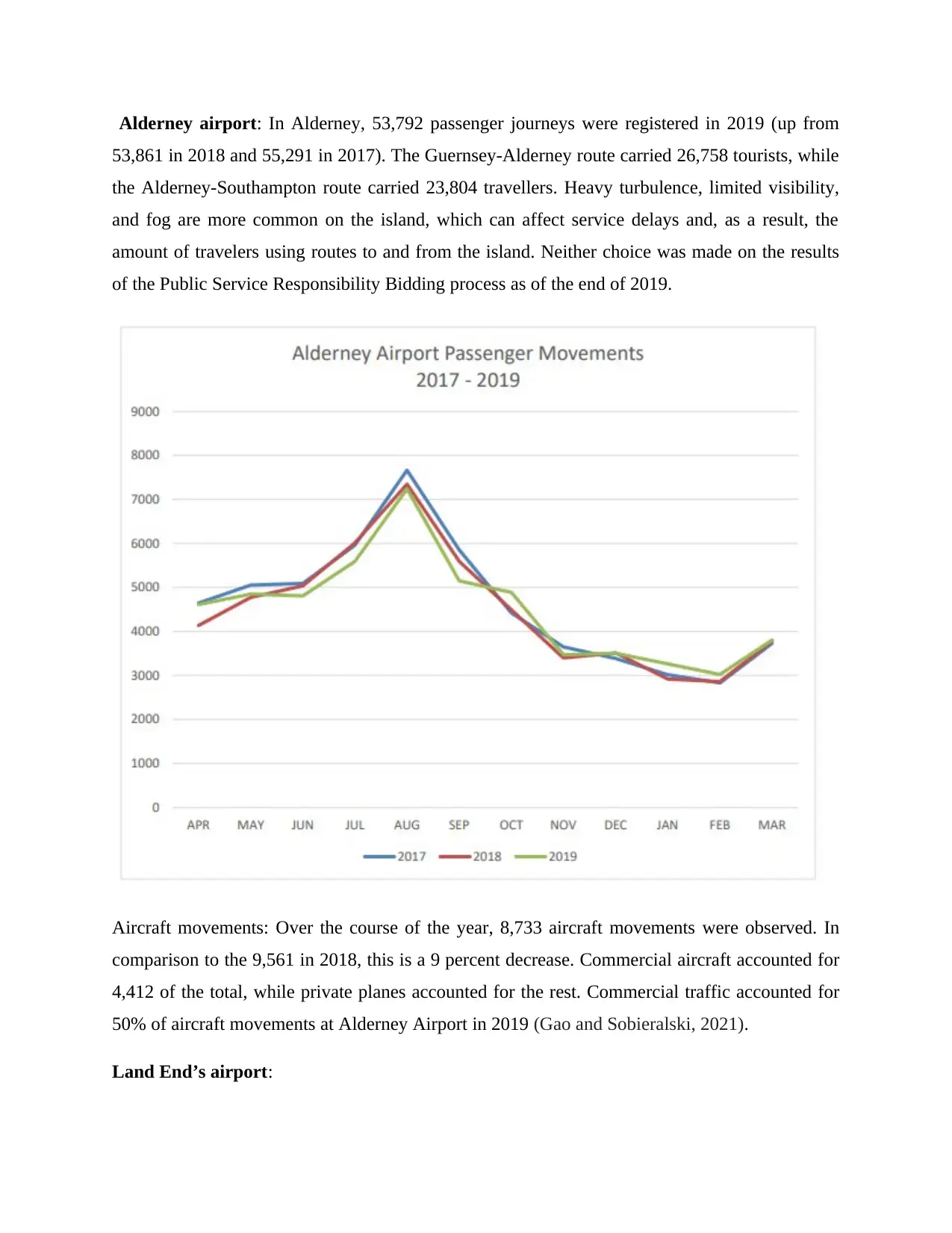
Alderney airport: In Alderney, 53,792 passenger journeys were registered in 2019 (up from
53,861 in 2018 and 55,291 in 2017). The Guernsey-Alderney route carried 26,758 tourists, while
the Alderney-Southampton route carried 23,804 travellers. Heavy turbulence, limited visibility,
and fog are more common on the island, which can affect service delays and, as a result, the
amount of travelers using routes to and from the island. Neither choice was made on the results
of the Public Service Responsibility Bidding process as of the end of 2019.
Aircraft movements: Over the course of the year, 8,733 aircraft movements were observed. In
comparison to the 9,561 in 2018, this is a 9 percent decrease. Commercial aircraft accounted for
4,412 of the total, while private planes accounted for the rest. Commercial traffic accounted for
50% of aircraft movements at Alderney Airport in 2019 (Gao and Sobieralski, 2021).
Land End’s airport:
53,861 in 2018 and 55,291 in 2017). The Guernsey-Alderney route carried 26,758 tourists, while
the Alderney-Southampton route carried 23,804 travellers. Heavy turbulence, limited visibility,
and fog are more common on the island, which can affect service delays and, as a result, the
amount of travelers using routes to and from the island. Neither choice was made on the results
of the Public Service Responsibility Bidding process as of the end of 2019.
Aircraft movements: Over the course of the year, 8,733 aircraft movements were observed. In
comparison to the 9,561 in 2018, this is a 9 percent decrease. Commercial aircraft accounted for
4,412 of the total, while private planes accounted for the rest. Commercial traffic accounted for
50% of aircraft movements at Alderney Airport in 2019 (Gao and Sobieralski, 2021).
Land End’s airport:
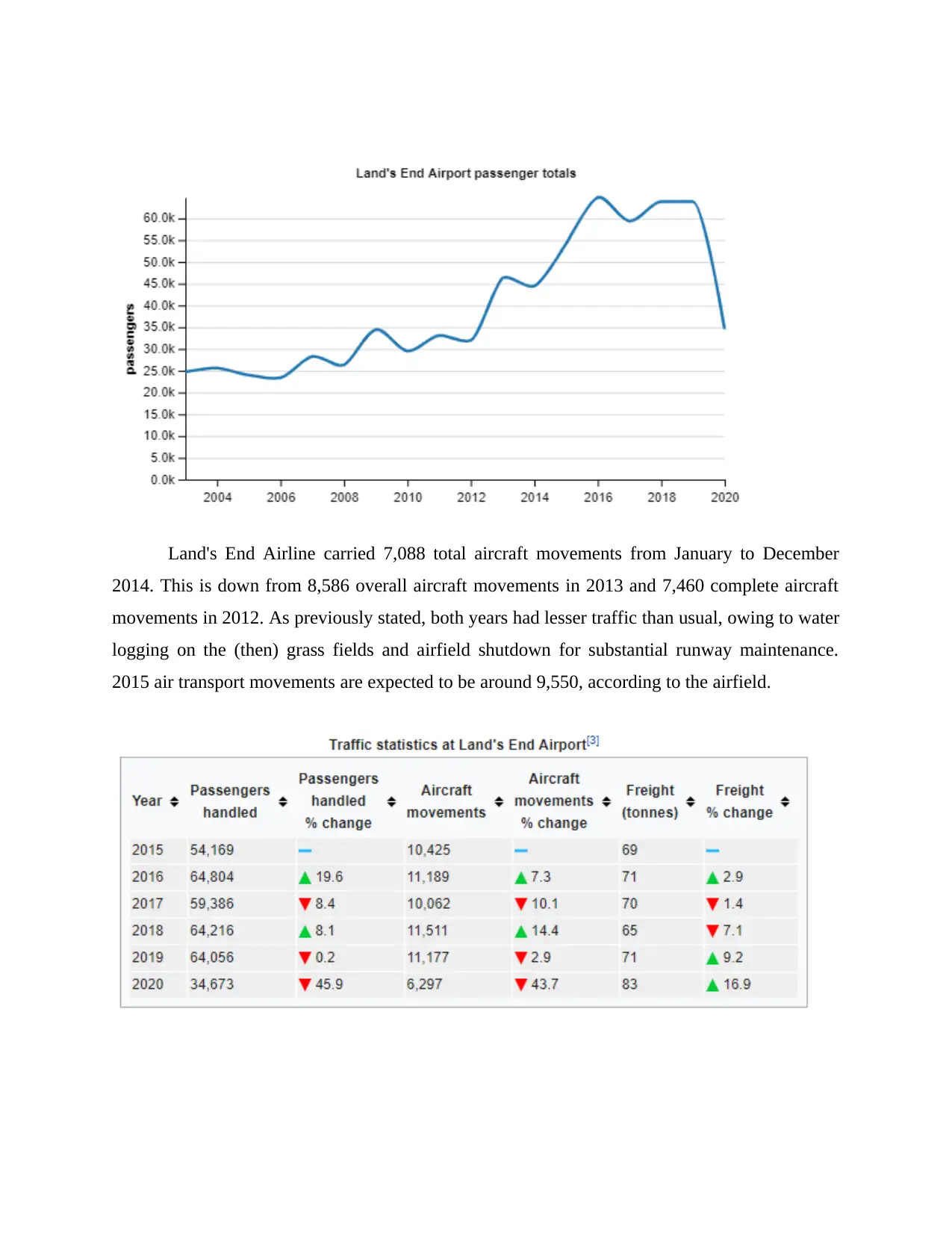
Land's End Airline carried 7,088 total aircraft movements from January to December
2014. This is down from 8,586 overall aircraft movements in 2013 and 7,460 complete aircraft
movements in 2012. As previously stated, both years had lesser traffic than usual, owing to water
logging on the (then) grass fields and airfield shutdown for substantial runway maintenance.
2015 air transport movements are expected to be around 9,550, according to the airfield.
2014. This is down from 8,586 overall aircraft movements in 2013 and 7,460 complete aircraft
movements in 2012. As previously stated, both years had lesser traffic than usual, owing to water
logging on the (then) grass fields and airfield shutdown for substantial runway maintenance.
2015 air transport movements are expected to be around 9,550, according to the airfield.
⊘ This is a preview!⊘
Do you want full access?
Subscribe today to unlock all pages.

Trusted by 1+ million students worldwide
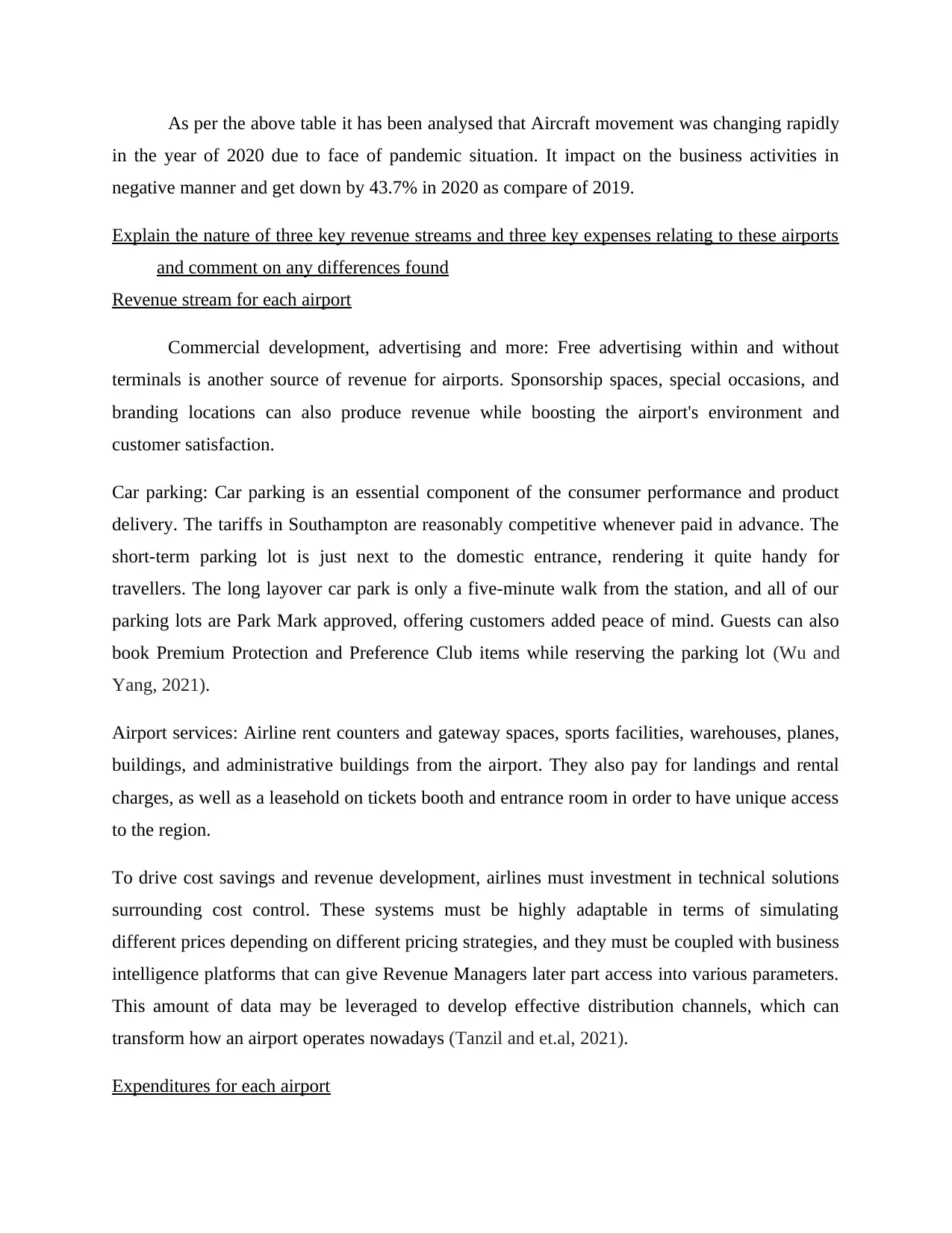
As per the above table it has been analysed that Aircraft movement was changing rapidly
in the year of 2020 due to face of pandemic situation. It impact on the business activities in
negative manner and get down by 43.7% in 2020 as compare of 2019.
Explain the nature of three key revenue streams and three key expenses relating to these airports
and comment on any differences found
Revenue stream for each airport
Commercial development, advertising and more: Free advertising within and without
terminals is another source of revenue for airports. Sponsorship spaces, special occasions, and
branding locations can also produce revenue while boosting the airport's environment and
customer satisfaction.
Car parking: Car parking is an essential component of the consumer performance and product
delivery. The tariffs in Southampton are reasonably competitive whenever paid in advance. The
short-term parking lot is just next to the domestic entrance, rendering it quite handy for
travellers. The long layover car park is only a five-minute walk from the station, and all of our
parking lots are Park Mark approved, offering customers added peace of mind. Guests can also
book Premium Protection and Preference Club items while reserving the parking lot (Wu and
Yang, 2021).
Airport services: Airline rent counters and gateway spaces, sports facilities, warehouses, planes,
buildings, and administrative buildings from the airport. They also pay for landings and rental
charges, as well as a leasehold on tickets booth and entrance room in order to have unique access
to the region.
To drive cost savings and revenue development, airlines must investment in technical solutions
surrounding cost control. These systems must be highly adaptable in terms of simulating
different prices depending on different pricing strategies, and they must be coupled with business
intelligence platforms that can give Revenue Managers later part access into various parameters.
This amount of data may be leveraged to develop effective distribution channels, which can
transform how an airport operates nowadays (Tanzil and et.al, 2021).
Expenditures for each airport
in the year of 2020 due to face of pandemic situation. It impact on the business activities in
negative manner and get down by 43.7% in 2020 as compare of 2019.
Explain the nature of three key revenue streams and three key expenses relating to these airports
and comment on any differences found
Revenue stream for each airport
Commercial development, advertising and more: Free advertising within and without
terminals is another source of revenue for airports. Sponsorship spaces, special occasions, and
branding locations can also produce revenue while boosting the airport's environment and
customer satisfaction.
Car parking: Car parking is an essential component of the consumer performance and product
delivery. The tariffs in Southampton are reasonably competitive whenever paid in advance. The
short-term parking lot is just next to the domestic entrance, rendering it quite handy for
travellers. The long layover car park is only a five-minute walk from the station, and all of our
parking lots are Park Mark approved, offering customers added peace of mind. Guests can also
book Premium Protection and Preference Club items while reserving the parking lot (Wu and
Yang, 2021).
Airport services: Airline rent counters and gateway spaces, sports facilities, warehouses, planes,
buildings, and administrative buildings from the airport. They also pay for landings and rental
charges, as well as a leasehold on tickets booth and entrance room in order to have unique access
to the region.
To drive cost savings and revenue development, airlines must investment in technical solutions
surrounding cost control. These systems must be highly adaptable in terms of simulating
different prices depending on different pricing strategies, and they must be coupled with business
intelligence platforms that can give Revenue Managers later part access into various parameters.
This amount of data may be leveraged to develop effective distribution channels, which can
transform how an airport operates nowadays (Tanzil and et.al, 2021).
Expenditures for each airport
Paraphrase This Document
Need a fresh take? Get an instant paraphrase of this document with our AI Paraphraser
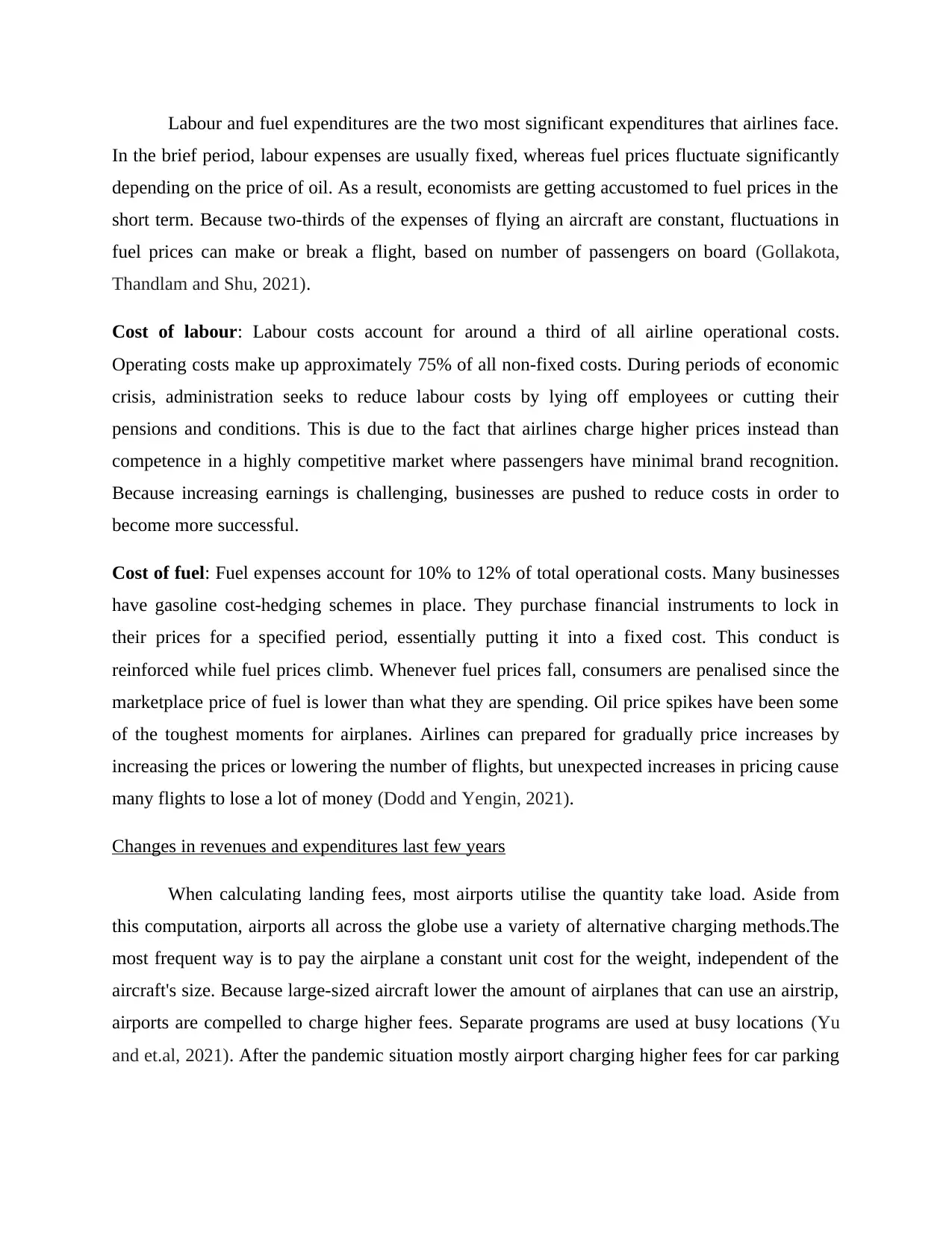
Labour and fuel expenditures are the two most significant expenditures that airlines face.
In the brief period, labour expenses are usually fixed, whereas fuel prices fluctuate significantly
depending on the price of oil. As a result, economists are getting accustomed to fuel prices in the
short term. Because two-thirds of the expenses of flying an aircraft are constant, fluctuations in
fuel prices can make or break a flight, based on number of passengers on board (Gollakota,
Thandlam and Shu, 2021).
Cost of labour: Labour costs account for around a third of all airline operational costs.
Operating costs make up approximately 75% of all non-fixed costs. During periods of economic
crisis, administration seeks to reduce labour costs by lying off employees or cutting their
pensions and conditions. This is due to the fact that airlines charge higher prices instead than
competence in a highly competitive market where passengers have minimal brand recognition.
Because increasing earnings is challenging, businesses are pushed to reduce costs in order to
become more successful.
Cost of fuel: Fuel expenses account for 10% to 12% of total operational costs. Many businesses
have gasoline cost-hedging schemes in place. They purchase financial instruments to lock in
their prices for a specified period, essentially putting it into a fixed cost. This conduct is
reinforced while fuel prices climb. Whenever fuel prices fall, consumers are penalised since the
marketplace price of fuel is lower than what they are spending. Oil price spikes have been some
of the toughest moments for airplanes. Airlines can prepared for gradually price increases by
increasing the prices or lowering the number of flights, but unexpected increases in pricing cause
many flights to lose a lot of money (Dodd and Yengin, 2021).
Changes in revenues and expenditures last few years
When calculating landing fees, most airports utilise the quantity take load. Aside from
this computation, airports all across the globe use a variety of alternative charging methods.The
most frequent way is to pay the airplane a constant unit cost for the weight, independent of the
aircraft's size. Because large-sized aircraft lower the amount of airplanes that can use an airstrip,
airports are compelled to charge higher fees. Separate programs are used at busy locations (Yu
and et.al, 2021). After the pandemic situation mostly airport charging higher fees for car parking
In the brief period, labour expenses are usually fixed, whereas fuel prices fluctuate significantly
depending on the price of oil. As a result, economists are getting accustomed to fuel prices in the
short term. Because two-thirds of the expenses of flying an aircraft are constant, fluctuations in
fuel prices can make or break a flight, based on number of passengers on board (Gollakota,
Thandlam and Shu, 2021).
Cost of labour: Labour costs account for around a third of all airline operational costs.
Operating costs make up approximately 75% of all non-fixed costs. During periods of economic
crisis, administration seeks to reduce labour costs by lying off employees or cutting their
pensions and conditions. This is due to the fact that airlines charge higher prices instead than
competence in a highly competitive market where passengers have minimal brand recognition.
Because increasing earnings is challenging, businesses are pushed to reduce costs in order to
become more successful.
Cost of fuel: Fuel expenses account for 10% to 12% of total operational costs. Many businesses
have gasoline cost-hedging schemes in place. They purchase financial instruments to lock in
their prices for a specified period, essentially putting it into a fixed cost. This conduct is
reinforced while fuel prices climb. Whenever fuel prices fall, consumers are penalised since the
marketplace price of fuel is lower than what they are spending. Oil price spikes have been some
of the toughest moments for airplanes. Airlines can prepared for gradually price increases by
increasing the prices or lowering the number of flights, but unexpected increases in pricing cause
many flights to lose a lot of money (Dodd and Yengin, 2021).
Changes in revenues and expenditures last few years
When calculating landing fees, most airports utilise the quantity take load. Aside from
this computation, airports all across the globe use a variety of alternative charging methods.The
most frequent way is to pay the airplane a constant unit cost for the weight, independent of the
aircraft's size. Because large-sized aircraft lower the amount of airplanes that can use an airstrip,
airports are compelled to charge higher fees. Separate programs are used at busy locations (Yu
and et.al, 2021). After the pandemic situation mostly airport charging higher fees for car parking
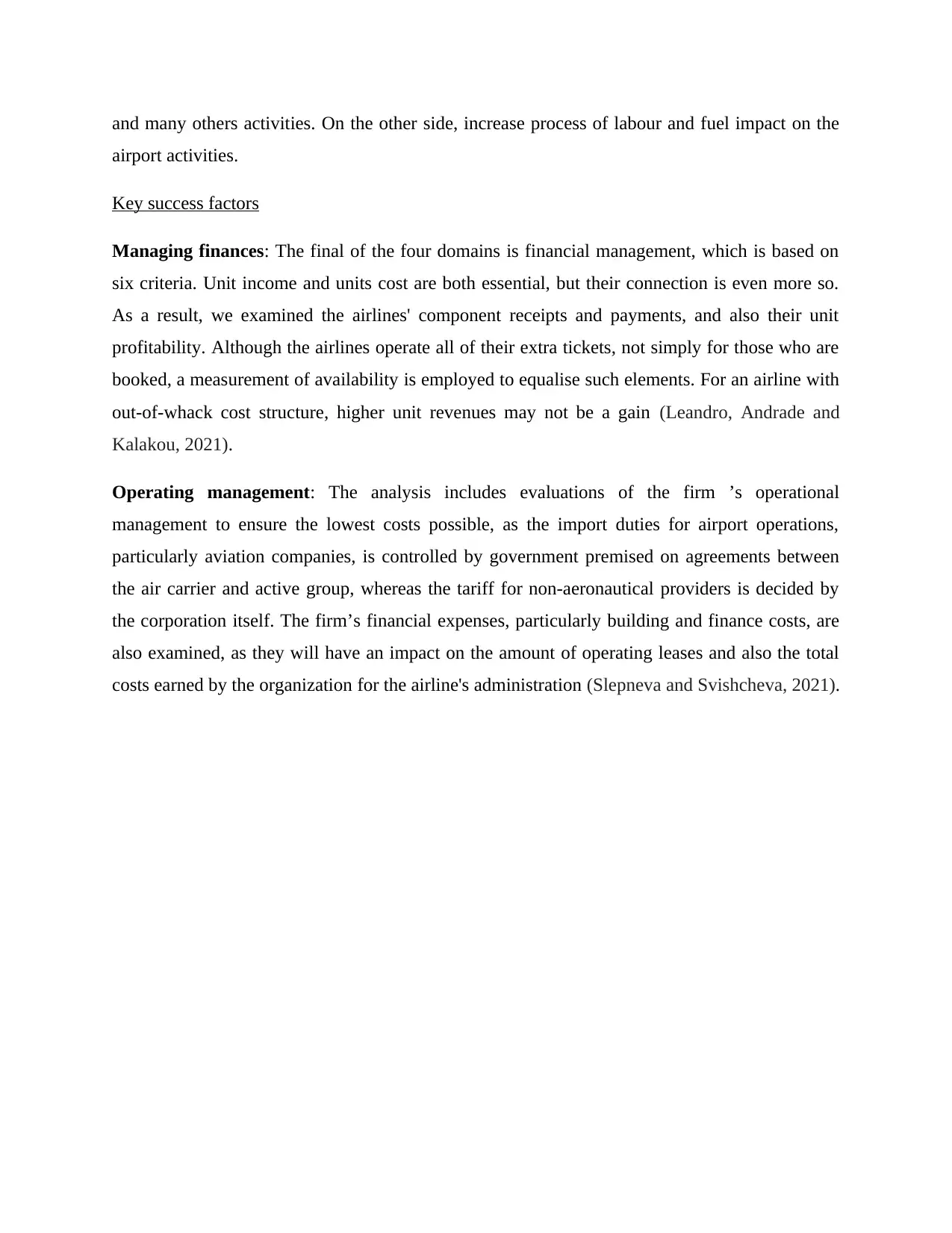
and many others activities. On the other side, increase process of labour and fuel impact on the
airport activities.
Key success factors
Managing finances: The final of the four domains is financial management, which is based on
six criteria. Unit income and units cost are both essential, but their connection is even more so.
As a result, we examined the airlines' component receipts and payments, and also their unit
profitability. Although the airlines operate all of their extra tickets, not simply for those who are
booked, a measurement of availability is employed to equalise such elements. For an airline with
out-of-whack cost structure, higher unit revenues may not be a gain (Leandro, Andrade and
Kalakou, 2021).
Operating management: The analysis includes evaluations of the firm ’s operational
management to ensure the lowest costs possible, as the import duties for airport operations,
particularly aviation companies, is controlled by government premised on agreements between
the air carrier and active group, whereas the tariff for non-aeronautical providers is decided by
the corporation itself. The firm’s financial expenses, particularly building and finance costs, are
also examined, as they will have an impact on the amount of operating leases and also the total
costs earned by the organization for the airline's administration (Slepneva and Svishcheva, 2021).
airport activities.
Key success factors
Managing finances: The final of the four domains is financial management, which is based on
six criteria. Unit income and units cost are both essential, but their connection is even more so.
As a result, we examined the airlines' component receipts and payments, and also their unit
profitability. Although the airlines operate all of their extra tickets, not simply for those who are
booked, a measurement of availability is employed to equalise such elements. For an airline with
out-of-whack cost structure, higher unit revenues may not be a gain (Leandro, Andrade and
Kalakou, 2021).
Operating management: The analysis includes evaluations of the firm ’s operational
management to ensure the lowest costs possible, as the import duties for airport operations,
particularly aviation companies, is controlled by government premised on agreements between
the air carrier and active group, whereas the tariff for non-aeronautical providers is decided by
the corporation itself. The firm’s financial expenses, particularly building and finance costs, are
also examined, as they will have an impact on the amount of operating leases and also the total
costs earned by the organization for the airline's administration (Slepneva and Svishcheva, 2021).
⊘ This is a preview!⊘
Do you want full access?
Subscribe today to unlock all pages.

Trusted by 1+ million students worldwide
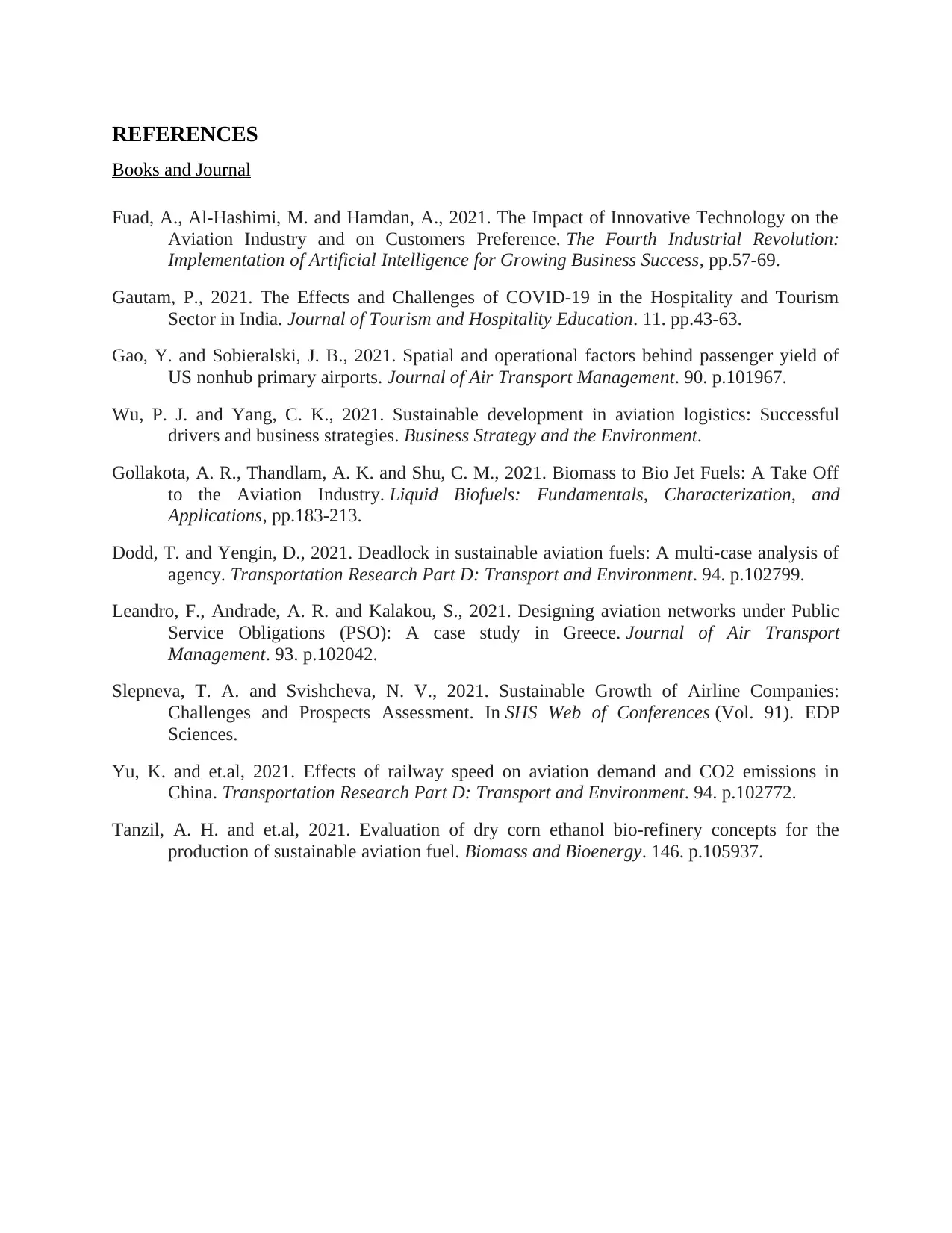
REFERENCES
Books and Journal
Fuad, A., Al-Hashimi, M. and Hamdan, A., 2021. The Impact of Innovative Technology on the
Aviation Industry and on Customers Preference. The Fourth Industrial Revolution:
Implementation of Artificial Intelligence for Growing Business Success, pp.57-69.
Gautam, P., 2021. The Effects and Challenges of COVID-19 in the Hospitality and Tourism
Sector in India. Journal of Tourism and Hospitality Education. 11. pp.43-63.
Gao, Y. and Sobieralski, J. B., 2021. Spatial and operational factors behind passenger yield of
US nonhub primary airports. Journal of Air Transport Management. 90. p.101967.
Wu, P. J. and Yang, C. K., 2021. Sustainable development in aviation logistics: Successful
drivers and business strategies. Business Strategy and the Environment.
Gollakota, A. R., Thandlam, A. K. and Shu, C. M., 2021. Biomass to Bio Jet Fuels: A Take Off
to the Aviation Industry. Liquid Biofuels: Fundamentals, Characterization, and
Applications, pp.183-213.
Dodd, T. and Yengin, D., 2021. Deadlock in sustainable aviation fuels: A multi-case analysis of
agency. Transportation Research Part D: Transport and Environment. 94. p.102799.
Leandro, F., Andrade, A. R. and Kalakou, S., 2021. Designing aviation networks under Public
Service Obligations (PSO): A case study in Greece. Journal of Air Transport
Management. 93. p.102042.
Slepneva, T. A. and Svishcheva, N. V., 2021. Sustainable Growth of Airline Companies:
Challenges and Prospects Assessment. In SHS Web of Conferences (Vol. 91). EDP
Sciences.
Yu, K. and et.al, 2021. Effects of railway speed on aviation demand and CO2 emissions in
China. Transportation Research Part D: Transport and Environment. 94. p.102772.
Tanzil, A. H. and et.al, 2021. Evaluation of dry corn ethanol bio-refinery concepts for the
production of sustainable aviation fuel. Biomass and Bioenergy. 146. p.105937.
Books and Journal
Fuad, A., Al-Hashimi, M. and Hamdan, A., 2021. The Impact of Innovative Technology on the
Aviation Industry and on Customers Preference. The Fourth Industrial Revolution:
Implementation of Artificial Intelligence for Growing Business Success, pp.57-69.
Gautam, P., 2021. The Effects and Challenges of COVID-19 in the Hospitality and Tourism
Sector in India. Journal of Tourism and Hospitality Education. 11. pp.43-63.
Gao, Y. and Sobieralski, J. B., 2021. Spatial and operational factors behind passenger yield of
US nonhub primary airports. Journal of Air Transport Management. 90. p.101967.
Wu, P. J. and Yang, C. K., 2021. Sustainable development in aviation logistics: Successful
drivers and business strategies. Business Strategy and the Environment.
Gollakota, A. R., Thandlam, A. K. and Shu, C. M., 2021. Biomass to Bio Jet Fuels: A Take Off
to the Aviation Industry. Liquid Biofuels: Fundamentals, Characterization, and
Applications, pp.183-213.
Dodd, T. and Yengin, D., 2021. Deadlock in sustainable aviation fuels: A multi-case analysis of
agency. Transportation Research Part D: Transport and Environment. 94. p.102799.
Leandro, F., Andrade, A. R. and Kalakou, S., 2021. Designing aviation networks under Public
Service Obligations (PSO): A case study in Greece. Journal of Air Transport
Management. 93. p.102042.
Slepneva, T. A. and Svishcheva, N. V., 2021. Sustainable Growth of Airline Companies:
Challenges and Prospects Assessment. In SHS Web of Conferences (Vol. 91). EDP
Sciences.
Yu, K. and et.al, 2021. Effects of railway speed on aviation demand and CO2 emissions in
China. Transportation Research Part D: Transport and Environment. 94. p.102772.
Tanzil, A. H. and et.al, 2021. Evaluation of dry corn ethanol bio-refinery concepts for the
production of sustainable aviation fuel. Biomass and Bioenergy. 146. p.105937.
1 out of 10
Your All-in-One AI-Powered Toolkit for Academic Success.
+13062052269
info@desklib.com
Available 24*7 on WhatsApp / Email
![[object Object]](/_next/static/media/star-bottom.7253800d.svg)
Unlock your academic potential
Copyright © 2020–2025 A2Z Services. All Rights Reserved. Developed and managed by ZUCOL.